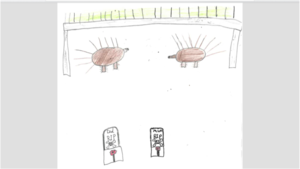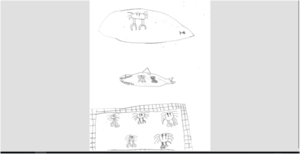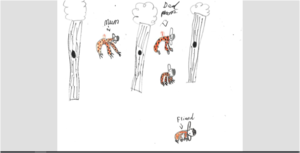Use of Therapeutic Storywriting to explore themes of loss with an adoptive child
Sam was in Year 5 when he was considered as a pupil that would benefit from being included in a Therapeutic Storywriting Group. He had joined the school in Year 1, after he and his siblings had been adopted. Prior to joining his adoptive family Sam had spent a short period of time in Foster Care after he and his siblings had been removed from their birth parents.
Sam was described as being a well-behaved pupil who engaged well with learning. He had been working with the Learning Mentor in School around issues relating to his emotional well-being. The Learning Mentor in School has a very good relationship with Sam and understands the complexity of his background. She has supported Sam and the family in relation to some of the anger Sam has expressed at home. The Learning Mentor and the family agreed that being part of the Therapeutic Storywriting Group might be a positive opportunity for Sam to explore different emotions in a creative context.
The Therapeutic Storywriting Group began in the spring term. There were four pupils in the group which was led by the Learning Mentor with the support of the school’s Assistant Headteacher. Both adults were very familiar to Sam.
During the first session of Therapeutic Storywriting the children were introduced to the structure of the group and then given a story opener. Sam worked on his story in a focused way and was happy to share what he had written. He produced a detailed picture to accompany his story.
Harry the Hedgehog peered through the leaves. He was feeling lonely because he had no friends and his mum and dad had passed away two months ago.
He met another hedgehog called Sally. They talked to each other and when Sally said she was lonely, Harry knew that feeling inside him. So Harry asked Sally over to his house to play hide and seek she said that she would love to because she wanted to play with him.
When they got to Sally’s house, they were attacked by foxes so they curled up into little balls so the foxes would get prickled and leave them alone.

Following the session, the staff running the group reflected on Sam’s story. As Therapeutic Storywriting is a therapeutic teaching intervention, the work is not about finding a ‘correct’ interpretation – the child may have a vivid imagination, have watched a video or read a book for inspiration for their story. However, by reflecting on the metaphor and providing indirect interpretation using the story metaphor, professionals communicate to the child that they have listened to and thought about their story.
In Sam’s first story the professionals thought that the inclusion of the gravestones in the picture, emphasised this as a very important element to the story. They wondered about the structure drawn over the two hedgehogs and what this might represent, whether it in some way was protecting the hedgehogs from the foxes or whether the hedgehog’s own prickles were enough protection.
Sam was happy to return to the second session of Therapeutic Storywriting. This is the second story he wrote along with an accompanying picture:
Colin the crab scuttled behind the water covered rock. He was worried because his family had been kidnapped by the sea. So he went after them, but he could not swim. He saw a boat and went on it to catch up with his family. When he was just about to jump in a white shark came and ate his family. When he saw it happen, he followed the shark and there was a cage of crabs, who had been shown missing on the news, and one of them was his friend called Mike.
Soon he was being chased but he couldn’t escape from the shark. Then he joined his family in the cage, cramped up with horrible, smelling, old crusty crabs. When he saw the cage open, with more crabs going in, he got out and went to shore.
Another day later he went back to rescue his fellow crabs.

The adults running the group considered how the themes in this story linked with Sam’s first story about the hedgehogs. They noted that this story also contained ideas about a lost family. They thought it was interesting that the group of crabs at the bottom of the picture were protected by a structure similar to that which had covered the hedgehogs in the first story, finding safety from the shark in a similar way to the hedgehogs hiding from the fox. They were very struck by the description of the other crabs in the cage in which Colin’s family found themselves.
During the third Therapeutic Storywriting group session Sam wrote the following story.
Jeremy the jaguar paced through the rainforest. He was feeling angry because someone had murdered his parents. When his friend told the whole entire rainforest, he knew it was someone in his family. When he asked him how he knew, he said it was because it was his dad that had killed them.
As it was his friend’s parents that had killed his, he thought they might as well get a dose of their own medicine.
When it was night, he sneaked into his friend’s house and got his dagger like claws and ripped them into his friend’s parent’s hearts. With a yelp of death his friend woke up and saw Jeremy kill his parents. He knew that he was in serious trouble now.
His friend started to pounce at him, but it would take more to scare him. When he saw him get his claws out he knew he was about to charge at him, but Jeremy swiped his claws at him and cut his head a little bit, then ripped him up.

The power of this story was exemplified by reflecting on the themes within Sam’s earlier stories, particularly around the loss of the key character’s parents. The murder of Jeremy’s parents in this story leads to the key character trying to work out who was responsible and then exact revenge.
After the third session, the stories were presented within a Therapeutic Storywriting Training session and the participants worked together with the staff from Sam’s school to identify themes in his stories. The group reflected on how strongly ideas of loss were represented in Sam’s stories, particularly in relation to the parents of key characters. It was noted that in the stories the parent was always taken from the key character rather than the key character being taken away.
The training participants also reflected on the role of the ‘friend’ in Sam’s stories. Sally the hedgehog had been important in the first story in terms of a character that Harry could identify with, who was experiencing similar feelings to him. It was through his encounter with Sally that Harry was able to be in touch with the loneliness he felt. In the second story, Colin’s friend Mike is seen in the cage captured with the other crabs, having been reported missing on the news. The group wondered about the role of Mike in this story and the significance of being missing.
The ‘friend’ character in Sam’s last story has a very different role, sharing the news of Jeremy’s parents murder and then admitting it was his own father that had killed Jeremy’s parents. The group noted that in the third story the friend was not given a name and wondered about the significance of this. The group were very struck by the description of the deaths of the friend’s parents and then the friend as they were given “a taste of their own medicine”.
The arrangement of the characters in the picture was thought about, particularly the way in which the trees divided Mum on one side and then Jeremy and Dad on the other. In comparison with the pictures from earlier stories it was noted that the structure surrounding the characters in this picture was not as enclosed and therefore did not appear as protective. It was suggested that in this story, by taking revenge on the Jaguars, it was not as necessary for the main character to be as protected.
When looking at of Sam’s stories together the training participants considered the different responses of the characters in relation to the threat they felt from various forms of attack and noted that the main characters appeared to get progressively braver. The adults that were running the group shared that during the three session Sam had appeared to become more confident and braver within the intervention group, sharing more and asking more questions of the other children.
Unfortunately, after his third session Sam’s experience of Therapeutic Storywriting was interrupted by the closure of schools that happened in March 2020 due to the coronavirus pandemic. It is hoped that when schools re-open in September the adults in school will be able to re-establish the group and Sam will continue with the intervention.
N.B. Name changed for confidentiality and permissions granted from parents and school for sharing of this case study
Author: Kirklees Educational Psychologist, August 2020
